Abstract
Background:
Approximately 80% of patients who underwent spinal surgeries experience moderate to extreme postoperative pain. Gabapentin was used as an adjunct for the management of acute pain in approximately half of enhanced recovery programs. This meta-analysis aimed to illustrate the efficacy and safety of gabapentin for pain management following spinal surgery.
Methods:
In January 2017, a systematic computer-based search was conducted in PubMed, EMBASE, Web of Science, Cochrane Database of Systematic Reviews, and Google database. Data on patients prepared for spine surgery in studies that compared gabapentin versus placebo were retrieved. The primary endpoint was the visual analog scale (VAS) at 12 hours and 24 hours and total morphine consumption. The secondary outcomes were complications that included nausea, dizziness, somnolence, headache, pruritus, urine retention, and vomiting. After testing for publication bias and heterogeneity between studies, data were aggregated for random-effects models when necessary.
Results:
Seven clinical studies with 581 patients (gabapentin group=383, control group=198) were ultimately included in the meta-analysis. Gabapentin was associated with reduced pain scores at 12 hours and 24 hours, corresponding to a reduction of 11.18 points (95% CI, –13.85 to –8.52 points) at 12 hours and 9.94 points (95% CI, –13.99 to –5.89 points) at 24 hours on a 100-point VAS. Similarly, gabapentin was associated with a reduction in total morphine consumption (–2.04, 95% CI –2.71, –1.37). Furthermore, gabapentin can reduce the occurrence of vomiting (risk ratio [RR] 0.46, 95% CI 0.27, 0.78, P = 0.004), urine retention (RR = 0.57, 95% CI 0.34, 0.98, P = 0.041, NNT = 11.9) and pruritus (RR = 0.38, 95% CI 0.22, 0.66, P = 0.001, NNT = 5.6) and the number needed to treat (NNT = 20.1). There were no significant differences in the occurrence of nausea, dizziness, somnolence, or headache.
Conclusions:
Gabapentin was efficacious in the reduction of postoperative pain, total morphine consumption, and morphine-related complications following spine surgery. In addition, a high dose (≥900 mg/d) of gabapentin is more effective than a low dose (<900 mg/d). The number of included studies is limited, and more studies are needed to verify the effects of gabapentin in spinal surgery patients.
Keywords: gabapentin, meta-analysis, spine surgery
1. Introduction
Previous reports revealed that approximately 80% of patients undergoing spinal surgeries experienced moderate to extreme postoperative pain.[1,2] Pain after surgery was associated with several complications: prolonged wound healing, increased infections, and added costs.[3] To achieve effective postoperative pain relief, multimodal therapy with 2 or more analgesics and modalities that work by different mechanisms to improve analgesia and reduce the severity of adverse effects are rising steadily.[4] Opioids are the first choice for treating moderate to severe postoperative pain, but their use is limited due to adverse effects such as nausea, vomiting, pruritus, and urinary retention.[5–7] For surgery, operatively induced neuroplastic changes may provoke sensitization and cause postoperative hyperalgesia or allodynia. Therefore, an optimal multimodal analgesic regimen, including antihyperanalgesic drugs to attenuate central sensitization, may have beneficial effects for pain control after surgery.
Gabapentin is an anticonvulsant agent that has an affinity to the alpha2delta subunit of voltage-dependent calcium channels and shows promising results in relieving chronic neuropathic pain.[8] It acts in synergy with morphine and has a preemptive effect as well.[9] Several randomized controlled trials (RCT) have compared gabapentin with control groups. Many of these trials contained relatively small samples and demonstrated inconsistent outcomes.[10,11] A previous meta-analysis compared gabapentinoids (gabapentin and pregabalin) to placebos for pain control in patients who underwent lumbar surgery. However, the disadvantages were as follows: (1) duplicate publications were included in the meta-analysis[10,12]; (2) complications of using gabapentin were not compared; (3) different doses of gabapentin were not compared; and (4) that study investigated the efficacy of gabapentinoids (gabapentin and pregabalin) for pain control after spinal surgery, but we cannot determine whether gabapentin positively or significantly influenced patients who underwent spinal surgery.[13] Additionally, more evidence is emerging, and it is necessary to re-evaluate the efficacy and safety of gabapentin for pain control after spinal surgery. This meta-analysis aimed to evaluate whether gabapentin can decrease pain intensity, total morphine consumption and related complications, and whether high-dose gabapentin is superior to low-dose gabapentin.
2. Materials and methods
This systematic review was reported according to the preferred reporting items for systematic reviews and meta-analyses (PRISMA) guidelines.[14]
2.1. Search strategies
The following databases were searched in September 2016 without restrictions on location or publication types: PubMed (1950–January 2017), EMBASE (1974–January 2017), the Cochrane Library (January 2017 Issue 3), and the Google database (1950–January 2017). The Mesh terms and their combinations used in the search were as follows: “analgesia” OR “pain management” OR “anesthetic agents” OR “lumbar surgery” OR “spinal surgery” OR “lumbar spine surgery” AND “gabapentin” [Mesh terms]. The reference lists of related reviews and original articles were searched for any relevant studies, including RCTs involving adult humans. Only articles originally written in English or translated into English were considered. When multiple reports describing the same sample were published, the most recent or complete report was used. This meta-analysis collected data from published articles and thus no ethic approval was necessary for this article.
3. Inclusion criteria and study selection
Patients: patients prepared for spine surgery (lumbar fusion, lumbar laminectomy, or lumbar discectomy); intervention: perioperative gabapentin used as an adjunct to multimodal anesthetics as an intervention group; comparison: placebo; outcomes: visual analog scale (VAS) at 12 hours and 24 hours, total morphine consumption and related complications (nausea, dizziness, somnolence, headache, pruritus, urine retention, and vomiting); study design: RCTs. Two independent reviewers screened the title and abstracts of the identified studies after removing the duplicates from the search results. Any disagreements about the inclusion or exclusion of a study were solved by discussion or consultation with an expert. The reliability of the study selection was determined by Cohen's kappa test, and the acceptable threshold value was set at 0.61[6,7].
4. Data abstraction and quality assessment
A specific extraction was conducted to collect data in a pre-generated standard Microsoft Excel (Microsoft Corporation, Redmond, Washington) file. The items extracted from relevant studies were as follows: first author and publication year, country, sample size of the intervention and control groups, preoperative and postoperative doses, timing and frequency and the total dose of gabapentin per number of days and follow-ups. Outcomes such as the VAS at 12 hours and 24 hours and related complications (nausea, dizziness, somnolence, headache, pruritus, urine retention, and vomiting) were abstracted and recorded in the spreadsheet. Postoperative pain intensity was measured using a 110-point VAS (0 = no pain and 100 = extreme pain). When the numerical rating scale (NRS) was reported, it was converted to a VAS. Additionally, a 10-point VAS was converted to a 100-point VAS.[15] Data in other forms (i.e., median, interquartile range, and mean ± 95% confidence interval [CI]) were converted to the mean ± standard deviation (SD) according to the Cochrane Handbook.[16] If the data were not reported numerically, we extracted these data using the “GetData Graph Digitizer” software from the published figures. All the data were extracted by 2 independent reviewers, and disagreements were resolved by discussion.
The quality of all included trials was independently assessed by 2 reviewers on the basis of the Cochrane Handbook for Systematic Reviews of Interventions, version 5.1.0 (http://www.cochrane-handbook.org/).[16] A total of 7 domains were used to assess the overall quality: random sequence generation, allocation concealment, blinding of participant and personnel, blinding of outcome assessment, incomplete outcome data, selective reporting and other bias. Each domain was measured as low bias, unclear bias or high bias.
5. Outcome measures and statistical analysis
Continuous outcomes (VAS at 12 hours and 24 hours) were expressed as the weighted mean differences (WMD) with 95% CI. Total morphine consumption was expressed as standard mean difference (SMD) with 95% CI as the unit in the included studies was different. Dichotomous outcomes (the occurrence of nausea, sedation, dizziness, headache, and visual disturbances) were expressed as a risk ratio (RR) with 95% CI. Statistical significance was set at P < 0.05 to summarize the findings across the trials. Variables in the meta-analysis were calculated using Stata software, version 12.0 (Stata Corp., College Station, TX). Statistical heterogeneity was evaluated using the chi-square test and the I2 statistic. When there was no statistical evidence of heterogeneity (I2 < 50%, P > 0.1), a fixed-effects model was adopted; otherwise, a random-effects model was chosen. Publication bias was tested using funnel plots. Publication bias was visually assessed using funnel plots and was quantitatively assessed using Begg's test. Subgroup analysis was conducted according to the dose of gabapentin (<900 mg/d or ≥900 mg/d). We considered there to be no publication bias if the funnel plot was symmetrical and the P-value was > 0.05. In addition, we calculated the number needed to harm (NNH) and the number need to treat (NNT) to examine the risks compared to the benefits of gabapentin therapy as it regarded complications.[17] The relationship between gabapentin dosage and the VAS at 12 hours and 24 hours was explored using SPSS software (SPSS Inc., Chicago, IL). The correlation coefficient (r) was used to evaluate the relationship between the dosage of gabapentin and the VAS at 12 hours and 24 hours.
6. Results
6.1. Search results and quality assessment
In the initial search, a total of 386 studies were identified from the electronic databases (PubMed = 112, EMBASE = 108, Web of Science = 60, Cochrane Library = 50, Google database = 56). Then, all papers were input into Endnote X7 (Thomson Reuters Corp.) software for the removal of duplicate papers. A total of 308 papers were reviewed and 209 papers were removed according to the inclusion criteria at abstract and title levels. Additionally, 1 study was a duplicate publication so we only included the most recently published paper.[10,12] Another study compared gabapentin to pregabalin without a control group of patients after lumbar disc herniation surgery, which was also excluded.[18] Ultimately, 7 clinical studies with 581 patients (gabapentin group = 383, control group = 198) were included in the meta-analysis.[4,10,11,19–22] The flow diagram for the included studies can be seen in Fig. 1. One study administered 4 different doses of gabapentin (300 mg/d, 600 mg/d, 900 mg/d and 1200 mg/d) versus placebo and the study was divided into 4 arms.[10] One study adopted 3 different gabapentin doses (600 mg/d, 900 mg/d and 1200 mg/d) and with different times of oral administration (preoperative and postoperative), this study was divided into 6 arms.[19] The general characteristics of the included studies can be seen in Table 1.
Figure 1.
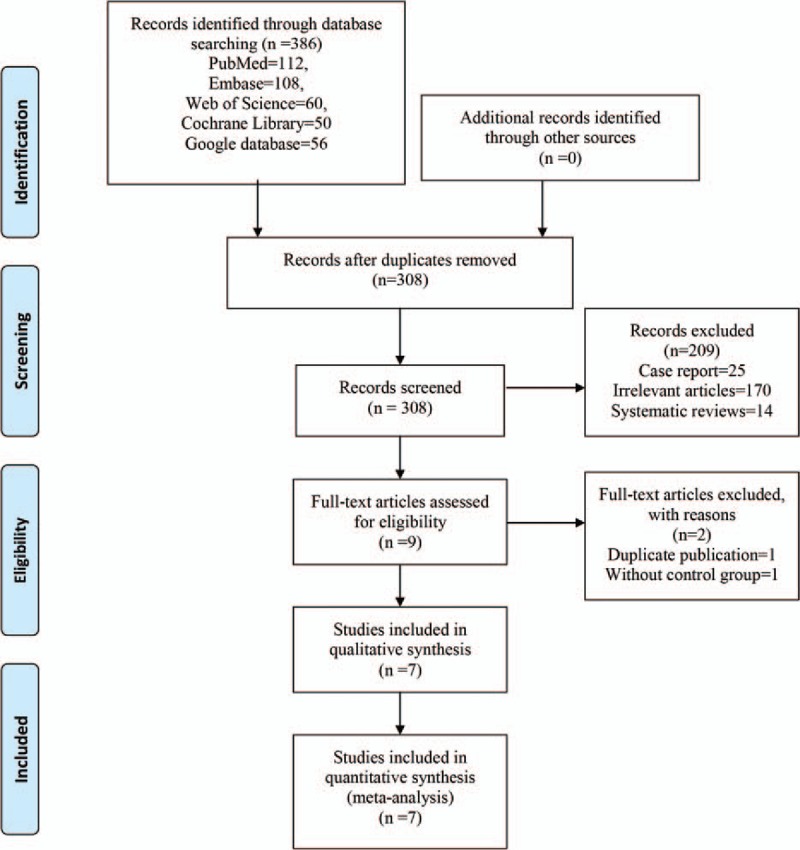
Flowchart of study search and inclusion criteria.
Table 1.
The general characteristics of the included studies.

The quality assessment of the included studies is summarized in Fig. 2. Only 2 studies did not describe the random sequence generation procedure[11,19]; the remaining 5 clinical trials performed appropriate random sequence generation. One study did not describe allocation concealment.[10] In addition, the risks of bias for blinding to the outcome assessment were unclear in 2 studies.[10,20] The overall kappa value regarding the evaluation of the risk of bias of included RCTs was 0.763, indicating that the agreement between the 2 reviewers was acceptable.
Figure 2.
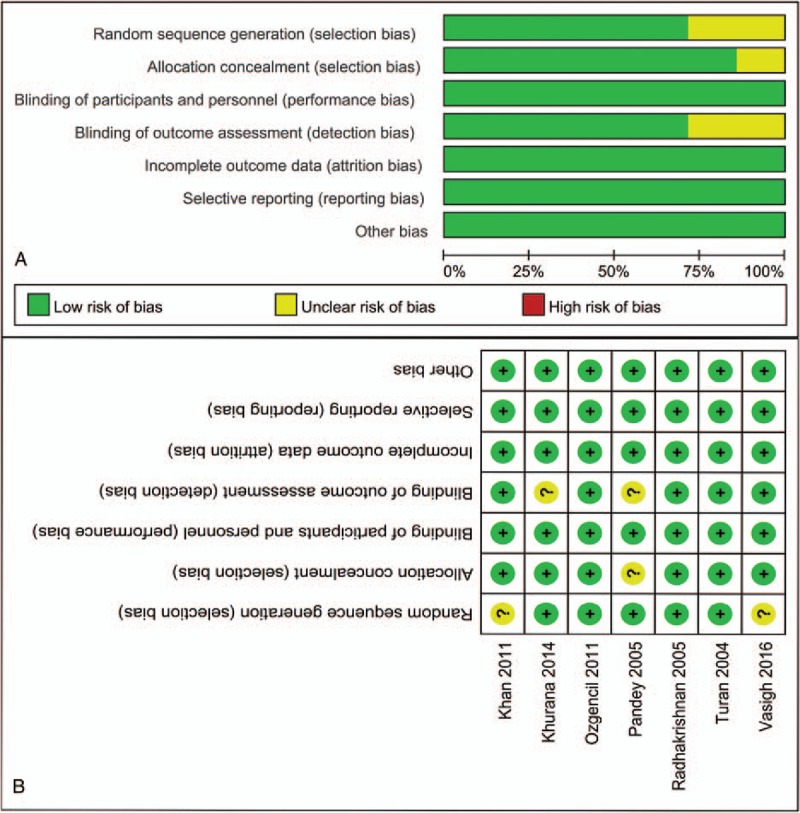
(A) The risk of bias graph. (B) Risk of bias of included randomized controlled trials. +, no bias; –, bias; ?, bias unknown.
7. Results of the meta-analysis
7.1. VAS at 12 hours and 24 hours
Postoperative VAS scores at 12 hours were reported in 3 studies[11,19,21,22], and the pooled results indicated that preoperative administration of gabapentin can decrease VAS scores at 12 hours (WMD = –11.18, 95% CI –13.85, –8.52, P = 0.000, Fig. 3). Postoperative VAS scores at 12 hours in the included studies had a large heterogeneity (I2=73.9%, P = 0.000), which required a random-effects model that was performed to analyze the data. The meta-analysis results indicated that gabapentin can decrease VAS scores at 24 hours (WMD = –9.94, 95% CI –13.99, –5.89, P = 0.000, Fig. 3). Postoperative VAS scores at 24 hours in the included studies had a large heterogeneity (I2=86.0%, P = 0.000), which required a random-effects model that was performed to analyze the relevant data. Funnel plots (Fig. 4A) and Begg's tests (Fig. 4B P = 0.784) were performed, and the results indicated that there was no publication bias between the included studies in terms of the VAS at 12 hours. Funnel plots (Fig. 5A) and Begg's tests (Fig. 5B P = 0.008) were performed, and the results indicated that there was publication bias between the included studies in terms of the VAS at 24 hours. A sensitivity analysis was then conducted to analyze the source of heterogeneity between the studies, and the results indicated that none of the included studies affected the final results (Fig. 6).
Figure 3.
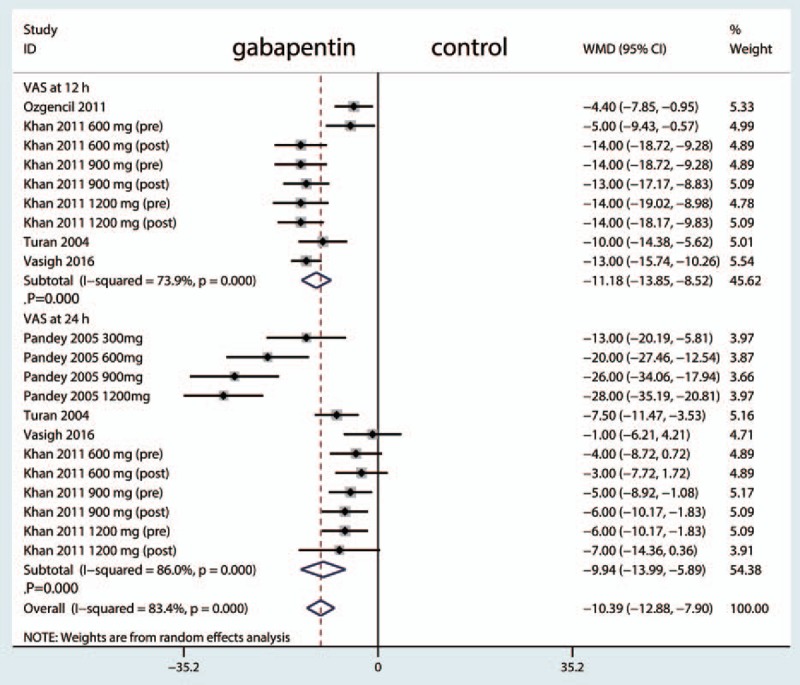
(A) Forest plots of the included studies comparing the VAS at 12 h. B, Forest plots of the included studies comparing the VAS at 24 h. VAS = visual analog scale.
Figure 4.

(A) Funnel plot of VAS at 12 h. (B) Begg's test of VAS at 12 h. VAS = visual analog scale.
Figure 5.

(A) Funnel plot of VAS at 24 h. (B) Begg's test of VAS at 24 h. VAS = visual analog scale.
Figure 6.
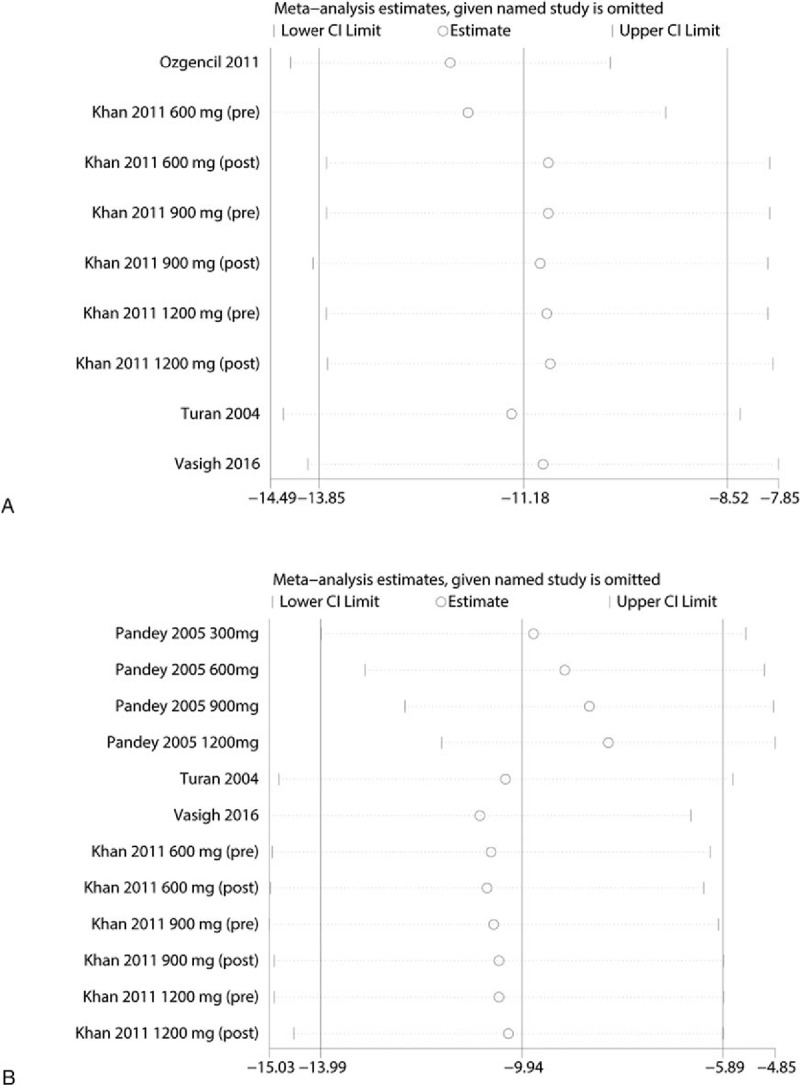
(A) Sensitivity analysis of the VAS at 12 h. (B) Sensitivity analysis of the VAS at 24 h. VAS = visual analog scale.
7.2. Dose–effect relationship
We plotted the gabapentin dose on the abscissa, with the corresponding VAS scores at 12 hours and 24 hours as the ordinate, to generate a scatterplot. In addition, the linear correlation coefficient (r) was also calculated. There was no positive correlation between the dosage of gabapentin and the VAS at 12 hours (r = –0.503, P = 0.737; Fig. 7A). A significantly positive correlation between the dosage of gabapentin and the VAS at 24 hours was found (r = –0.734, P = 0.007; Fig. 7B). The VAS at 24 hours tended to decrease as the gabapentin dose increased.
Figure 7.
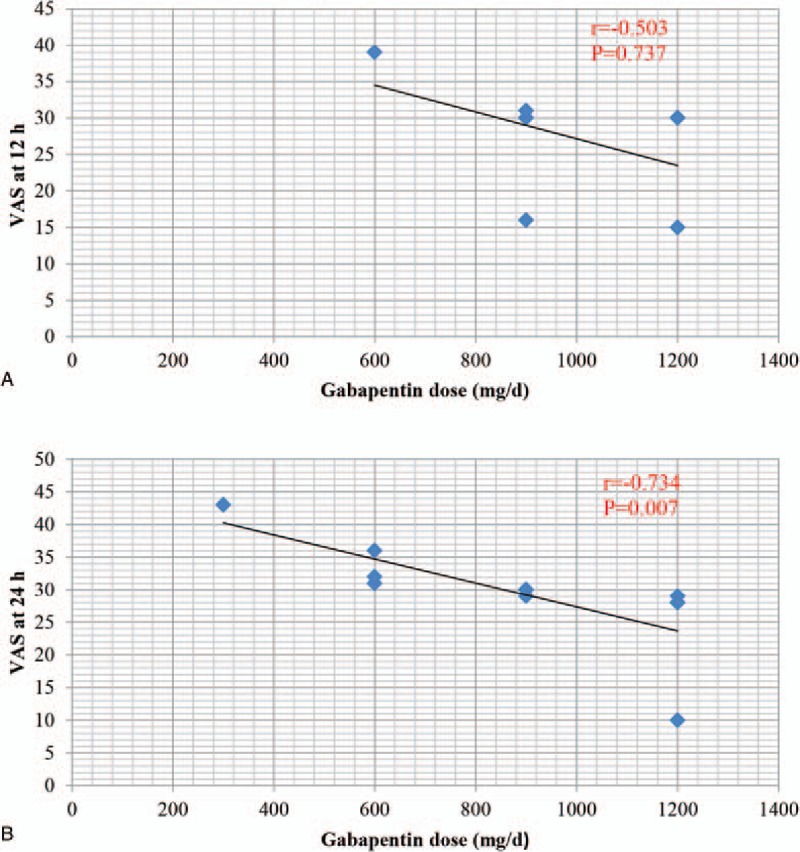
(A) Scatter plot showing the relationship between the dose of gabapentin and the VAS at 12 h. (B) Scatter plot showing the relationship between the dose of gabapentin and the VAS at 24 h. VAS = visual analog scale.
7.3. Total morphine consumption
Total morphine consumption was presented in 6 studies.[4,10,11,19,21,22] One study adopted different 4 doses of gabapentin compared to a placebo and was consequently divided into 4 groups.[10] The pooled results indicated that gabapentin can reduce total morphine consumption (SMD = –2.04, 95% CI –2.71, –1.37, P = 0.000, Fig. 8).
Figure 8.
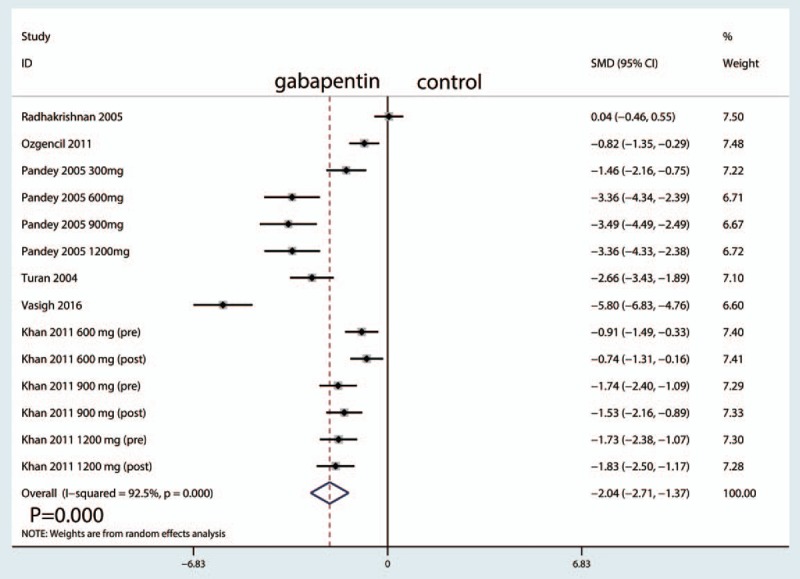
Forest plots of the included studies comparing the total morphine consumption.
7.4. Complications
There were no significant differences between the groups in the occurrence of nausea (RR = 0.74, 95% CI 0.49, 1.12, P = 0.157, NNT=34.8, Fig. 9A), dizziness (RR=1.56, 95% CI 0.93, 2.61, P = 0.094, Fig. 9B, NNH=27), somnolence (RR=1.57, 95% CI 0.66, 3.74, P = 0.308, Fig. 9C NNH=21.3), or headache (RR=0.88, 95% CI 0.45, 1.73, P = 0.709, Fig. 9D, NNT = 89). The administration of gabapentin could also decrease the occurrence of pruritus (RR = 0.38, 95% CI 0.22, 0.66, P = 0.001, Fig. 10A, NNT = 5.6), urine retention (RR = 0.57, 95% CI 0.34, 0.98, P = 0.041, Fig. 10B, NNT = 11.9), and vomiting (RR = 0.46, 95% CI 0.27, 0.78, P = 0.004, Fig. 10C, NNT = 20.1).
Figure 9.

Forest plots of the included studies comparing the occurrence of (A) nausea, (B) dizziness, (C) somnolence, (D) headache.
Figure 10.
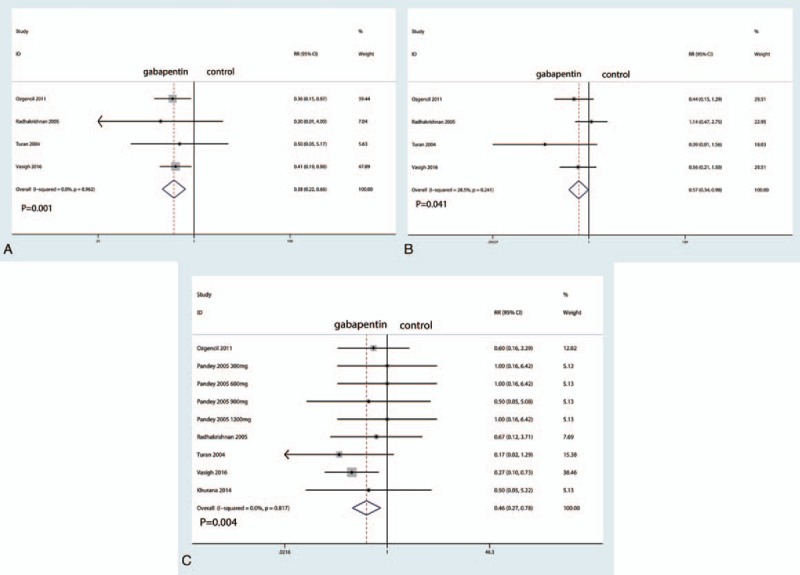
Forest plots of the included studies comparing the occurrence of (A) pruritus, (B) urine retention, (C) vomiting.
7.5. Subgroup analysis
Subgroup analyses were conducted according to a low dose (<900 mg/d) and a high dose of gabapentin (≥900 mg/d). The detailed results can be seen in Table 2. The pooled results indicated that a high dose of gabapentin can reduce VAS scores at 12 hours and 24 hours, total morphine consumption, vomiting, and urine retention compared to that of a low dose (P < 0.05).
Table 2.
Subgroup analysis for the VAS at 12 h, 24 h, total morphine consumption, the occurrence of vomiting, nausea, dizziness, urine retention, pruritus, and headache.
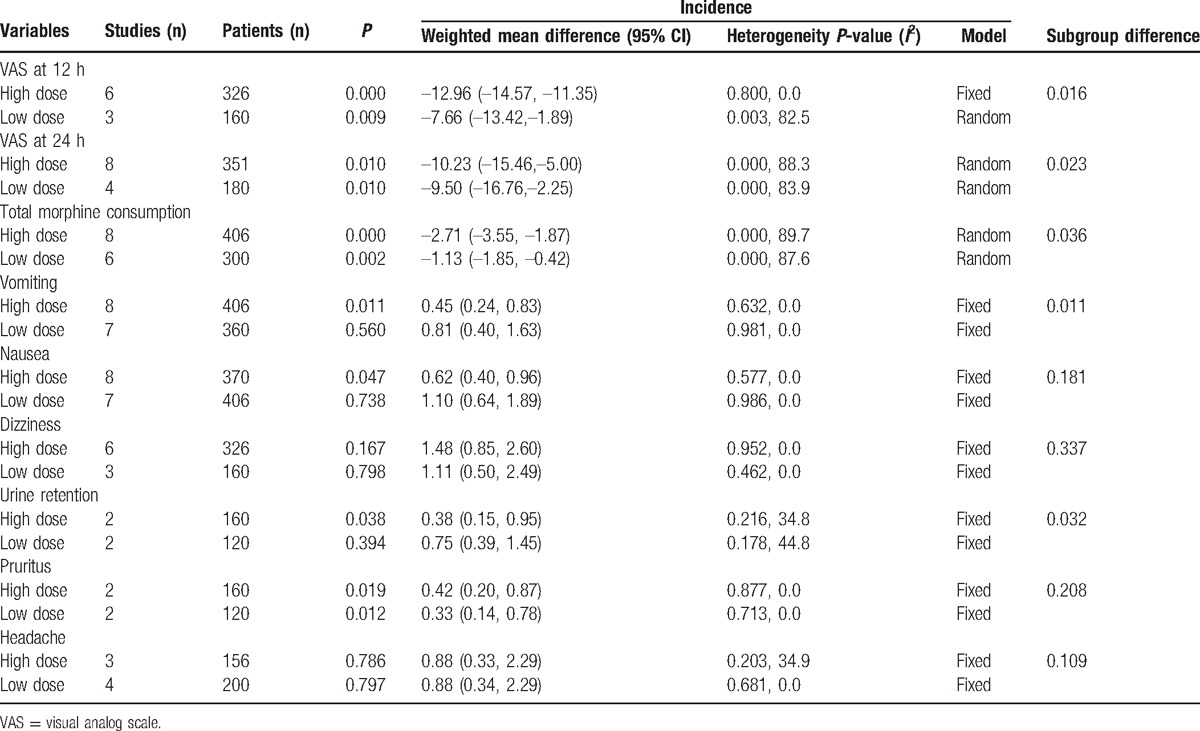
8. Discussion
The current meta-analysis demonstrated that the use of gabapentin was associated with reduced pain scores at 12 hours and 24 hours, which was equivalent on a 110-point VAS to 11.18 points at 12 hours and 9.94 points at 24 hours. The cumulative total morphine consumption was reduced in the gabapentin group. The most important finding of this meta-analysis was that gabapentin can reduce the occurrence of pruritus, urine retention, and vomiting after spinal surgery and high-dose gabapentin is superior to low-dose gabapentin. There were no significant differences in the occurrences of nausea, somnolence, headache, and dizziness. A major strength of this study is the comprehensive search with strict statistical calculations. Another strength is that we performed a dose–effect relationship between the dose of gabapentin with the VAS at 12 hours and 24 hours. In addition, there was a positive correlation between the gabapentin dose with the VAS at 24 hours.
Pooled results indicated that gabapentin can decrease the VAS at 12 hours and 24 hours by 9.18 points and 15.16 points e, respectively, with clinical significance. Additionally, the dose–effect relationship between gabapentin with VAS at 12 hours and 24 hours was performed and found that the VAS at 24 hours had a tendency to decrease as the gabapentin dose increased. The difference was statistically significant (P < 0.05). For the VAS at 12 hours, more relevant studies were needed to further identify the dose–response effects. Subgroup analysis results were in accordance with the dose-effect. Previous meta-analyses revealed that gabapentin exerts an analgesic and opioid-sparing effect in acute postoperative pain management without increasing the rate of dizziness and pruritus after total knee arthroplasty (TKA).[23] These results are contradictory to a previous meta-analysis that compared gabapentinoids (gabapentin or pregabalin) to placebos for managing pain after TKA. In that meta-analysis, the results indicated that no evidence supported the routine use of gabapentin after TKA.[24]
The current meta-analysis indicated that the use of gabapentin can also decrease total morphine consumption in spinal surgery (SMD = –2.04, 95% CI –2.71, –1.37, P = 0.000). Yu et al[13] revealed that gabapentin can decrease total morphine consumption (SMD = –1.47, 95% CI: –2.21, –0.73, P = 0.0001). Arumugam et al[25] revealed that the preoperative administration of gabapentin significantly reduced postoperative opioid consumption. However, orthopedic surgery, abdominal hysterectomy, thyroid surgery, and cholecystectomy were all included and diluted the evidence for the routine use of gabapentin in spinal surgery.
Morphine-related complications were also compared between the gabapentin and control groups. A reduction in the incidence of postoperative pruritus, urine retention, and vomiting following spine surgery was observed. To prevent a single case of pruritus, urine retention, and vomiting, the NNT is 5.6, 11.9 and 20.1, respectively. There were no significant differences between the occurrence of nausea, dizziness, somnolence, and headache (P > 0.05). Meanwhile, subgroup analyses results indicated that high-dose gabapentin can also decrease the occurrence of nausea (P < 0.05).
There were several limitations in this meta-analysis: (1) only 7 RCTs were included, which might have affected the precision of the effect size estimations; (2) follow-up in the included studies ranged from 24 hours to 6 month, and the relatively short-term follow-up may underestimate the complication rate; (3) dosage and timing of gabapentin administration differed between the studies, and although a subgroup analysis was conducted to decrease the heterogeneity, that could affect the precision of the results; (4) multiple analgesic approaches differed from each other, and consistent multiple analgesic approaches are needed to identify the most effective pain control method; and (5) publication bias existed in the VAS at 12 hours and may affect the final results.
9. Conclusion
In conclusion, some immediate analgesic efficacy and opioid-sparing effects (pruritus, urine retention, and vomiting) were obtained with the administration of gabapentin. Additionally, the analgesic efficacy and opioid-sparing effects were obvious in the high-dose gabapentin group. Because the sample size and the number of included studies were limited, a multicenter RCT is needed to identify the effects of gabapentin in reducing acute pain after spinal surgery.
Footnotes
Abbreviations: CI = confidence interval, NNH = number needed to harm, NNT = number need to treat, NRS = numerical rating scale, PRISMA = preferred reporting items for systematic reviews and meta-analyses, RCTs = randomized controlled trials, RR = risk ratio, SD = standard deviation, SMD = standard mean difference, VAS = visual analog scale, WMD = weighted mean differences.
The authors have no funding and conflicts of interest to disclose.
References
- [1].Apfelbaum JL, Chen C, Mehta SS, et al. Postoperative pain experience: results from a national survey suggest postoperative pain continues to be undermanaged. Anesth Analg 2003;97:534–40. table of contents. [DOI] [PubMed] [Google Scholar]
- [2].Ravindran D. Chronic postsurgical pain: prevention and management. J Pain Palliat Care Pharmacother 2014;28:51–3. [DOI] [PubMed] [Google Scholar]
- [3].Dong J, Li W, Wang Y. The effect of pregabalin on acute postoperative pain in patients undergoing total knee arthroplasty: a meta-analysis. Int J Surg 2016;34:148–60. [DOI] [PubMed] [Google Scholar]
- [4].Radhakrishnan M, Bithal PK, Chaturvedi A. Effect of preemptive gabapentin on postoperative pain relief and morphine consumption following lumbar laminectomy and discectomy: a randomized, double-blinded, placebo-controlled study. J Neurosurg Anesthesiol 2005;17:125–8. [DOI] [PubMed] [Google Scholar]
- [5].Dolin SJ, Cashman JN. Tolerability of acute postoperative pain management: nausea, vomiting, sedation, pruritus, and urinary retention. Evidence from published data. Br J Anaesth 2005;95:584–91. [DOI] [PubMed] [Google Scholar]
- [6].Pavlin DJ, Chen C, Penaloza DA, et al. Pain as a factor complicating recovery and discharge after ambulatory surgery. Anesth Analg 2002;95:627–34. table of contents. [DOI] [PubMed] [Google Scholar]
- [7].Sun XL, Zhao ZH, Ma JX, et al. Continuous local infiltration analgesia for pain control after total knee arthroplasty: a meta-analysis of randomized controlled trials. Medicine (Baltimore) 2015;94:e2005. [DOI] [PMC free article] [PubMed] [Google Scholar]
- [8].Shahid M, Subhan F, Ahmad N, et al. Topical gabapentin gel alleviates allodynia and hyperalgesia in the chronic sciatic nerve constriction injury neuropathic pain model. Eur J Pain 2016;21:668–80. [DOI] [PubMed] [Google Scholar]
- [9].Matthews EA, Dickenson AH. A combination of gabapentin and morphine mediates enhanced inhibitory effects on dorsal horn neuronal responses in a rat model of neuropathy. Anesthesiology 2002;96:633–40. [DOI] [PubMed] [Google Scholar]
- [10].Pandey CK, Navkar DV, Giri PJ, et al. Evaluation of the optimal preemptive dose of gabapentin for postoperative pain relief after lumbar diskectomy: a randomized, double-blind, placebo-controlled study. J Neurosurg Anesthesiol 2005;17:65–8. [DOI] [PubMed] [Google Scholar]
- [11].Vasigh A, Jaafarpour M, Khajavikhan J, et al. The effect of gabapentin plus celecoxib on pain and associated complications after laminectomy. J Clin Diagn Res 2016;10:Uc04–8. [DOI] [PMC free article] [PubMed] [Google Scholar]
- [12].Pandey CK, Sahay S, Gupta D, et al. Preemptive gabapentin decreases postoperative pain after lumbar discoidectomy. Can J Anaesth 2004;51:986–9. [DOI] [PubMed] [Google Scholar]
- [13].Yu L, Ran B, Li M, et al. Gabapentin and pregabalin in the management of postoperative pain after lumbar spinal surgery: a systematic review and meta-analysis. Spine (Phila Pa 1976) 2013;38:1947–52. [DOI] [PubMed] [Google Scholar]
- [14].Liberati A, Altman DG, Tetzlaff J, et al. The PRISMA statement for reporting systematic reviews and meta-analyses of studies that evaluate healthcare interventions: explanation and elaboration. BMJ 2009;339:b2700. [DOI] [PMC free article] [PubMed] [Google Scholar]
- [15].Wang C, Cai X-Z, Yan S-G. Comparison of periarticular multimodal drug injection and femoral nerve block for postoperative pain management in total knee arthroplasty: a systematic review and meta-analysis. J Arthroplasty 2015;30:1281–6. [DOI] [PubMed] [Google Scholar]
- [16].GS HJ. Cochrane handbook for systematic reviews of interventions version 5.1.0. Available at: [http://handbook.cochrane.org/]. Accessed 2011. [Google Scholar]
- [17].Laupacis A, Sackett DL, Roberts RS. An assessment of clinically useful measures of the consequences of treatment. N Engl J Med 1988;318:1728–33. [DOI] [PubMed] [Google Scholar]
- [18].Dolgun H, Turkoglu E, Kertmen H, et al. Gabapentin versus pregabalin in relieving early post-surgical neuropathic pain in patients after lumbar disc herniation surgery: a prospective clinical trial. Neurol Res 2014;36:1080–5. [DOI] [PubMed] [Google Scholar]
- [19].Khan ZH, Rahimi M, Makarem J, et al. Optimal dose of pre-incision/post-incision gabapentin for pain relief following lumbar laminectomy: a randomized study. Acta Anaesthesiol Scand 2011;55:306–12. [DOI] [PubMed] [Google Scholar]
- [20].Khurana G, Jindal P, Sharma JP, et al. Postoperative pain and long-term functional outcome after administration of gabapentin and pregabalin in patients undergoing spinal surgery. Spine (Phila Pa 1976) 2014;39:E363–368. [DOI] [PubMed] [Google Scholar]
- [21].Ozgencil E, Yalcin S, Tuna H, et al. Perioperative administration of gabapentin 1,200 mg day-1 and pregabalin 300 mg day-1 for pain following lumbar laminectomy and discectomy: a randomised, double-blinded, placebo-controlled study. Singapore Med J 2011;52:883–9. [PubMed] [Google Scholar]
- [22].Turan A, Karamanlioglu B, Memis D, et al. Analgesic effects of gabapentin after spinal surgery. Anesthesiology 2004;100:935–8. [DOI] [PubMed] [Google Scholar]
- [23].Zhai L, Song Z, Liu K. The effect of gabapentin on acute postoperative pain in patients undergoing total knee arthroplasty: a meta-analysis. Medicine (Baltimore) 2016;95:e3673. [DOI] [PMC free article] [PubMed] [Google Scholar]
- [24].Hamilton TW, Strickland LH, Pandit HG. A meta-analysis on the use of gabapentinoids for the treatment of acute postoperative pain following total knee arthroplasty. J Bone Joint Surg Am 2016;98:1340–50. [DOI] [PubMed] [Google Scholar]
- [25].Arumugam S, Lau CS, Chamberlain RS. Use of preoperative gabapentin significantly reduces postoperative opioid consumption: a meta-analysis. J Pain Res 2016;9:631–40. [DOI] [PMC free article] [PubMed] [Google Scholar]


